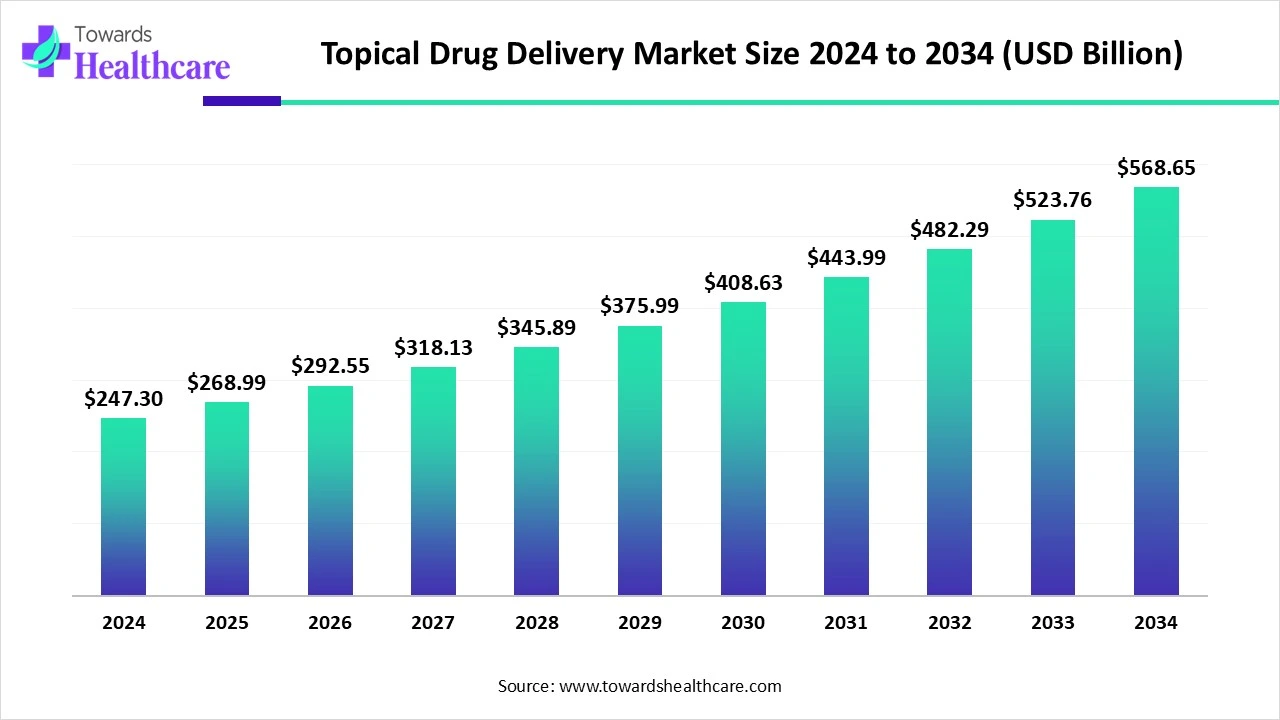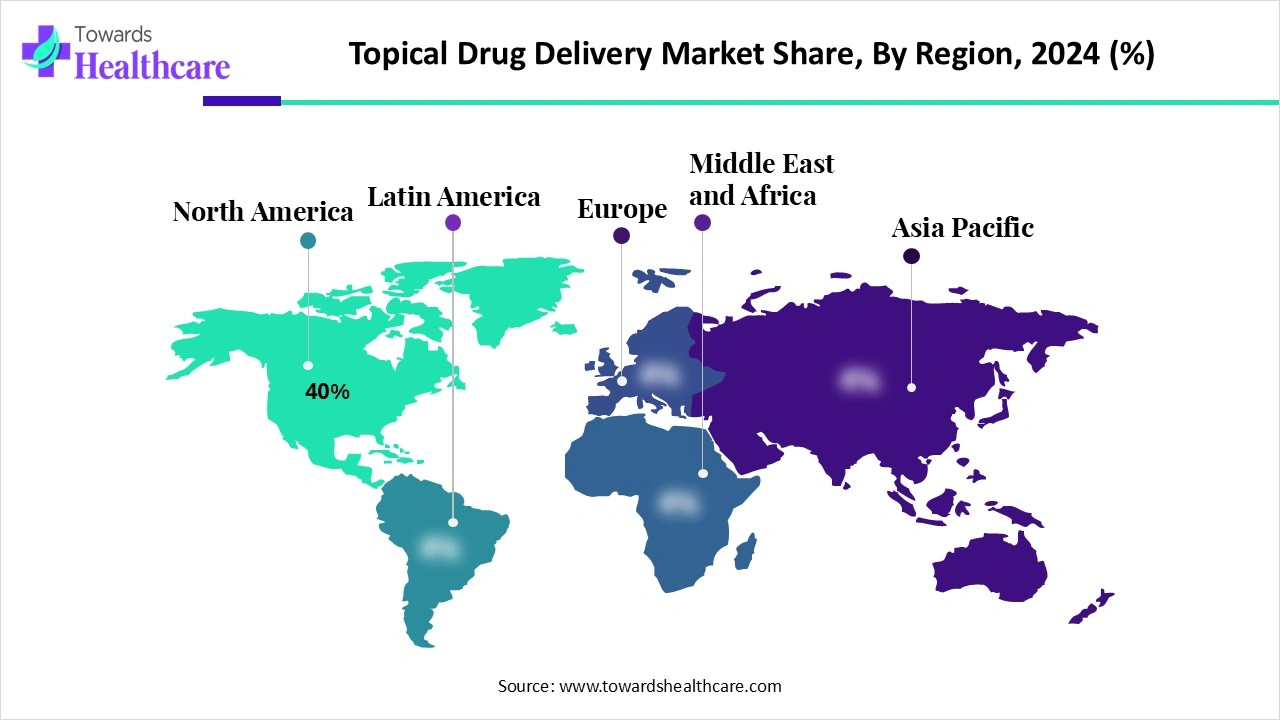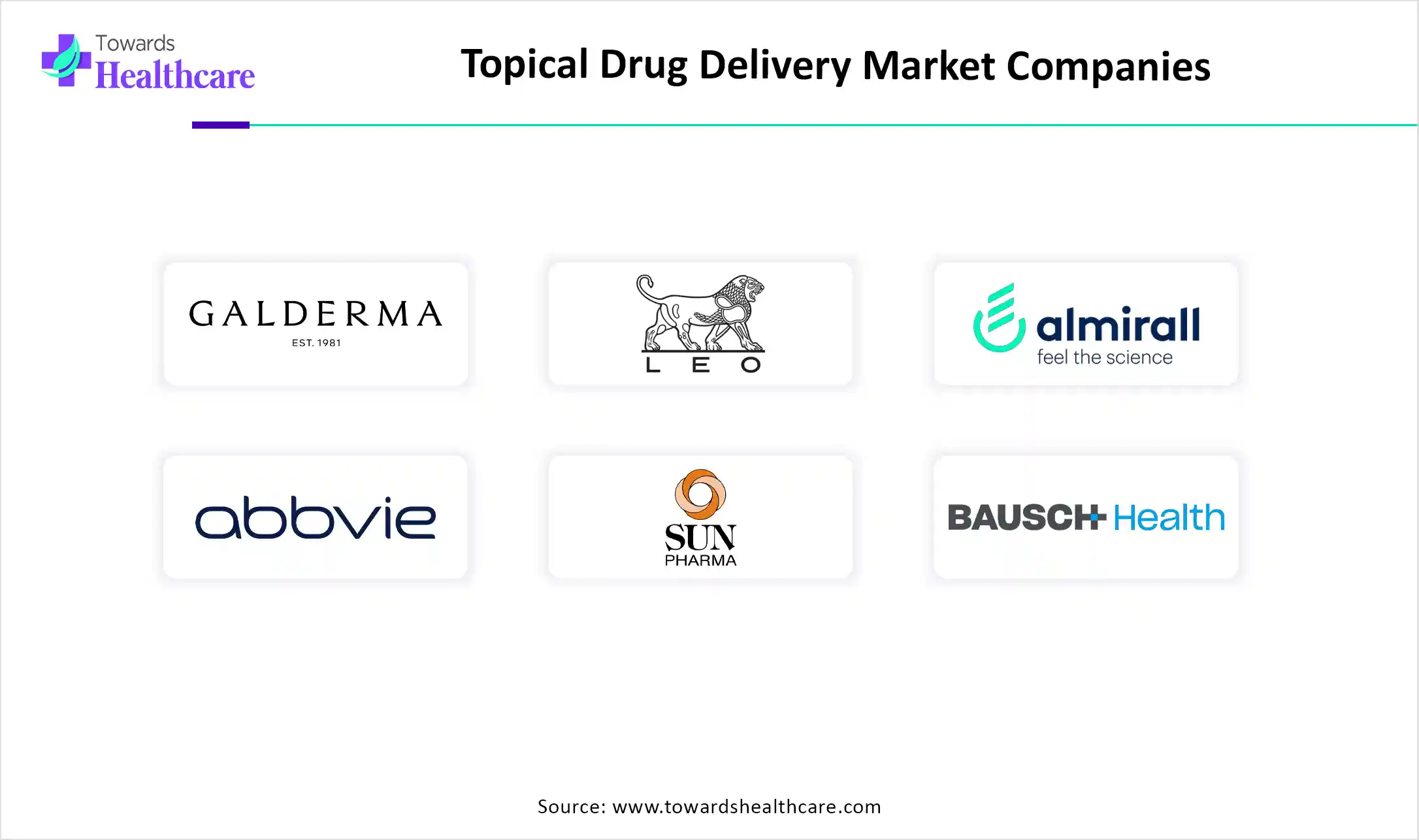November 2025

The global topical drug delivery market size is calculated at US$ 247.3 billion in 2024, grew to US$ 268.99 billion in 2025, and is projected to reach around US$ 568.65 billion by 2034. The market is expanding at a CAGR of 8.76% between 2025 and 2034.

In the US, China, India, South Korea, and other high-income countries, are is a specific rise in the geriatric population linked with severe skin diseases, like acne, psoriasis, atopic dermatitis, etc, which is boosting higher adoption of innovative and effective topical drug delivery approaches. The global topical drug delivery market further consists of the transforming steps in liposomes, nano-emulsions, and microneedle patches, which ultimately support novel drug delivery approaches in rising skin concerns and other topical chronic issues. Apart from this, 2025 is accelerating the progression of AI technologies and other digital health technologies, which offer convenient, cost-effective, and self-administerable solutions at home.
| Table | Scope |
| Market Size in 2025 | USD 268.99 Billion |
| Projected Market Size in 2034 | USD 568.65 Billion |
| CAGR (2025 - 2034) | 8.76% |
| Leading Region | North America Share 40% |
| Market Segmentation | By Formulation, By Application / Therapy Area, By Route of Administration, By Delivery System / Technology, By End User / Channel, By Region |
| Top Key Players | Galderma, LEO Pharma, Almirall, AbbVie, Sun Pharma, Bausch Health, Bausch + Lomb, Santen Pharmaceutical, Alcon, Viatris, Teva Pharmaceutical Industries, Perrigo Company, GSK, Bayer Consumer Health, Johnson & Johnson, Hisamitsu Pharmaceutical, Teikoku Pharma USA, Kindeva Drug Delivery, Corium, Inc., LTS Lohmann Therapie-Systeme |
The topical drug delivery market includes prescription and OTC medicines formulated for local or systemic delivery via the skin and mucosa (dermal/cutaneous, transdermal patches, ophthalmic, otic, nasal-topical, rectal, and vaginal). These products treat dermatologic diseases, pain and musculoskeletal conditions, infections, inflammatory disorders, women’s health conditions, and ocular surface diseases. Growth is propelled by rising dermatology prevalence (acne, psoriasis, atopic dermatitis), patient preference for non-invasive, self-administered therapies, advances in patches and nano-enabled carriers, and strong OTC/e-commerce demand.
In 2025, the market is experiencing major growth due to the widespread adoption of AI, machine learning, and other AI-powered techniques. This further assists in the excellent detection of drug candidates, improving formulations for stability and release, and customizing treatments as per requirements. Alongside, the respective market is widely adopting the AI-based design of microneedle arrays for transdermal delivery. Considering certain cases, like Moderna applies AI and ML to improve the delivery of mRNA-based therapies, including topical therapeutics.
Expansion in Skin Diseases and Topical Treatments
Currently, the global topical drug delivery market is driven by a rise in the prevalence of skin diseases, such as eczema, psoriasis, and acne. Moreover, these cases are fueling advancements in topical formulation and treatments, including groundbreaking developments in liposomes, nano-emulsions, and microneedle patches are optimizing drug absorption, efficacy, and delivery. Along with this, researchers are accelerating novel developments in topical treatments, comprising innovations in non-invasive approaches than other drug delivery methods, with a minimization of risks of systemic side effects.
Limitations in Formulation and Skin Health
Around the world, nowadays, one of the major challenges is to maintain a drug’s solubility, stability, and compatibility with excipients. This also affects on required drug release. Whereas, different topical products consisting of corticosteroids, some topical antibiotics, and other active ingredients are impacting skin health by causing allergic reactions or irritation.
Progression in Novel Transdermal Patches
The global topical drug delivery market will encompass various opportunities for topical drug delivery systems, including the developments in oncology, especially for skin cancers and cancer accessible through the skin. During the forecast period, the market is aiming at the establishment of transdermal patches for pain management and hormone therapy, which also gives a convenient and less invasive alternative to injections. Additionally, a wide range of adoption of integrated wearable technology and telehealth platforms with topical treatments can boost adherence monitoring and expand patient outcomes.
The semi-solids segment accounted for the biggest revenue share of the global topical drug delivery market in 2024. Numerous semi-solid formulations, like ointments, gels, and creams, etc are possess several advantages, mainly their ease of application. As well as being non-invasive, which makes it comfortable for patients’ concerns. Moreover, semi-solids have versatility in drug delivery as they can accommodate a wide range of drug molecules and have broader effectiveness of skin diseases. Also, the growing demand for home care settings, semi-solid formulations plays a vital role in self-administration.
However, the patches segment is expected to expand rapidly in the coming era. As this kind of formulation enables ease of application and self-administration is fueling the reduction of healthcare expenditure and frequent doctor visits. Also, these patches deliver drugs through the skin and into the bloodstream, which allows their use in diverse concerns, like pain management, hormone replacement therapy, and smoking cessation. On the other hand, ongoing advances in patch design, materials, and drug loading capacity are escalating their adoption in the developing skin issues.
In 2024, the dermatology segment registered dominance in the market. The segment is primarily propelled by a rise in skin diseases, particularly acne, psoriasis, eczema, and skin infections, which are boosting prominent demand for novel and effective topical treatments. Alongside, the growing geriatric population is highly prone to these skin concerns and other chronic conditions, like arthritis and neuropathic pain, who need convenient and self-administerable topical approaches at home.
Although the pain & musculoskeletal segment is predicted to expand at a rapid CAGR during the forecast period. In 2025, the globe is facing several cases of sports injuries, accidents, and age-related wear and tear, which are mainly impacting the overall segment expansion and the adoption of rigorous topical treatments. Alongside, these topical treatments assist in pain management solutions by reducing the risk of systemic side effects, which are frequently linked with oral therapeutics. A widespread focus on patient compliance, convenience, and easy usage is driving the segment growth.
By route of administration, the dermal/cutaneous segment led the global topical drug delivery market in 2024. The advantages of this segment are the possession of high concentrations of drugs, which further help in the site of action and minimize systemic drug levels and side effects. Prominent breakthroughs in nanotechnology, comprising nanoparticles and liposomes, are expanding drug penetration and efficacy in topical formulations. Furthermore, a major development in novel technologies, like microneedles and nanocarriers, is also fueling the overall market expansion.
And, the transdermal segment is anticipated to grow rapidly in the studied years. This segment encompasses numerous approaches, such as microneedles, iontophoresis, and electroporation, which support comprehensive drug efficacy. Also, the application of transdermal patches provides a painless and convenient approach for patients to overcome the disadvantages of the oral route. Besides this, this kind of route of administration assists in avoiding the first-pass metabolism with enhanced bioavailability. Nowadays, people are fostering the use of ultrasound and electrical currents for broader drug penetration, with low-frequency sonophoresis showing certain effects in recent research.
By delivery system/technology, the conventional topicals segment was dominant in the global topical drug delivery market in 2024. This type of delivery approach can target organs, including the skin and eyes, making it a preferred route for the local administration of active compounds. Alongside, due to its cost-effectiveness and convenience in the rising aging population, it is widely adopted. Usually, conventional topicals are highly tolerated, have ease of administration, and enable excellent safety properties are also boosting the ultimate market growth.
During 2025-2034, the transdermal patches segment is predicted to expand at the fastest CAGR in the market. Currently, researchers have given their results in the formation of groundbreaking transdermal patches, especially smart patches, degradable, dimensional (3D)-printed patches, and release patches etc. As well as they are also focusing on the development of hydrogels by exploring their bioavailability and sensing physiological characteristics, such as temperature, pH, and even blood sugar levels. Moreover, the segment will have the opportunity to integrate with wearable devices for consistent monitoring and drug delivery, which leads to a more convenient and user-friendly solution.
In 2024, the retail & OTC pharmacies segment dominated the market by accounting for the largest revenue share. The retail & OTC pharmacies are playing a crucial role in the availability, affordability, and self-treatment methods. They also provide a wide range of product variety, like creams, ointments, gels, lotions, and patches, which further accelerates OTC drugs demand among the population. The presence of well-trained pharmacists enables guidance on the proper application and duration of topical treatments to boost patient belief and adherence to this segment.
The online pharmacies/e-commerce segment is estimated to witness the fastest expansion during the forecast period. Along with price-sensitivity, this segment offers deeper information regarding topical drugs, particularly their ingredients, usage instructions, and possible side effects. This further expands e-commerce activities with raised remote patient monitoring and drug delivery. As these platforms give numerous customer reviews and testimonials offer insights into the experiences of other users, which assists customers in making informed decisions. Also, 2025 is a digitally transforming era, which is impacting the acceleration of digital health services by increasing awareness about online healthcare services and their advantages among the public.

In the global topical drug delivery market share 40%, North America registered dominance in 2024. Growth factors like the escalating skin concerns among the geriatric population and, presence of favourable reimbursement policies are widely impacting this region’s market development. Also, North America is propelled by ongoing technological advances and widespread instances of burn injuries, which are highly demanding topical antimicrobial agents and sophisticated dressings. Additionally, they are emphasizing the progression of precision medicine with customized topical formulations.
The US’s robust and well-equipped healthcare systems are driving the adoption of innovative transdermal approaches in the developing skin disease cases, resulting in the expansion of the topical drug delivery market.
For this market,
Canada’s accelerating awareness about skin concerns and innovative topical drug delivery systems are fueling the topical drug delivery market growth.
For instance,
During 2025-2034, the Asia Pacific is estimated to grow at a rapid CAGR in the topical drug delivery market. The region is driven by widespread efforts on the transformation in aesthetic treatments and skincare, and growing disposable income in ASAP’s countries. Furthermore, China, India, Japan, and South Korea are experiencing development due to their governments' encouragement for healthcare reform and infrastructure development. Along with this, continuous fostering of the transdermal system and related treatment approaches in the ASAP is also expanding the ultimate market.
In October 2024, China’s National Medical Products Administration approved Sino Biopharmaceutical Ltd.’s rivastigmine transdermal patch to treat mild to moderate Alzheimer’s disease.
In July 2024, Chowis Co. Ltd., a global provider of AI skin diagnostic solutions in South Korea, made a strategic collaboration with Kolmar Korea to develop an advanced customized cosmetics diagnostic platform.
In 2025, Europe is experiencing a notable growth in the topical drug delivery market. The region is widely focusing on healthcare spending, especially in Germany, to support the healthcare system and adopt well-developed topical drug delivery approaches. Along with this, Europe is expanding its E-pharmacy and outpatient services hub across the region, which makes topical medications more accessible to consumers.
For this market,
The global topical drug delivery market has specific steps in its R&D approaches, such as the discovery of novel molecules, formulating them into desired topical products, and testing their efficacy and safety through drug penetration.
Key Players: Bayer AG, 3M, Bausch Health Companies Inc., and Glenmark Pharmaceuticals, etc.
Inclusion of pre-formulation studies, like droplet size determination, zeta potential, size distribution, viscosity, pH, self-emulsification, cloud point, etc., further assists the assessment of formulation through membrane release and incorporation of additives in the final dosage.
Key Players: Johnson & Johnson, Novartis, Pfizer, and Kindeva Drug Delivery, etc.
In different phases of clinical trials, detection of the required dose, the drug’s safety, efficacy, and ultimately identifying possible adverse reactions or allergies occurring among patients are carried out. Also, this further supports the regulatory approval procedure of the topical drug delivery market.
Key Players: Cliantha Research, Dow Development Labs, Synapse Labs, US FDA, EMA, and other regulatory bodies etc.

By Formulation
By Application / Therapy Area
By Route of Administration
By Delivery System / Technology
By End User / Channel
By Region
November 2025
November 2025
November 2025
November 2025